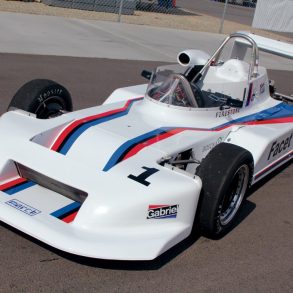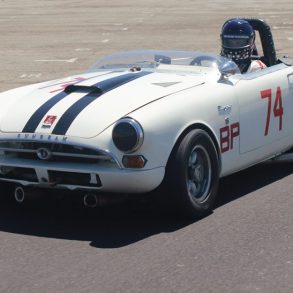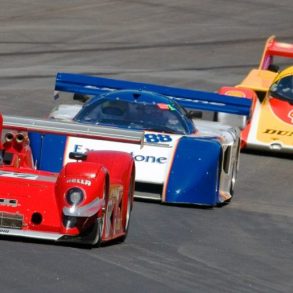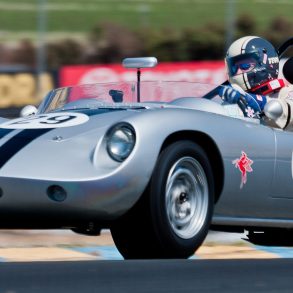During the fifties, I not only had a business relationship with Bill Devin, but we were also friends. We saw each other rather frequently in later years when he and his wife, Mildred, (we called her “Middie”) moved close to my Palm Springs house. When Bill passed away in November 2000, Middie asked me to deliver the eulogy. And, since now I’m the only survivor among the group directly involved with Bill in those days, a number of Devin enthusiasts have asked me to write about him.

I first came into contact with Bill due to my association with OCee Ritch. (OCee is not a typo—it’s an American Indian name.) In 1956, both he and I were into auto-related advertising and public relations. With the idea that the whole might be greater than the parts, we formed a partnership. One of OCee’s clients was Devin Enterprises.
At that time, Devin Enterprises was located in El Monte, California. Bill was making fiberglass bodies by the hundreds. The idea was to replace the stock body on whatever car you had. There were a few others in the same business, but Bill’s products were unique. His were not only the most beautiful, but he also made them in 27 different sizes to fit almost any chassis. Each body came in two pieces with one half fitting inside the other, creating an economic shipping package. Additionally, the seats were an integral part of the body and the deck lids were finished off complete with hinges. Bill took great care and pride in his molds. The result was a body of the highest quality.
The shape resembled something that might have come from one of the famous Italian coachbuilders. Various journalists and so-called experts claimed Bill had made a mold from one or another Italian body. But I don’t think this was true. Yes, Bill was obviously influenced by Italian designs, but I know—because I saw it—that he had a body he made of clay from which molds were made. Bill was always a little insulted when accused of “ripping off” another’s design.
Bill started out life in the automotive business. His father had a Chevrolet agency and garage in Rocky, Oklahoma, when Bill was born in 1915. He learned how to weld working in the garage. After serving in the Navy during WWII, Bill eventually bought a Chrysler-Plymouth agency in Fontana, California, where the family settled down.
Like some other returning veterans, Bill got interested in racing. He bought a Crosley Hot Shot, entered a novice race at Buchannan Field in August 1951, and won. This was followed by 22 overall or class wins in 22 starts. After a short-lived partnership with Ernie McAfee, he acquired a Deutsch-Bonnet with a Panhard engine. Not happy with its performance, he built a special, based on the car with a fiberglass body he designed. The result was the famous Devin-Panhard. During 1955, he built 11 additional units. Various drivers—including Jack Douglas, James Orr and Jean-Pierre Kunstle—scored many victories including the SCCA National (class) Championship in 1956.
By 1956, the after-market fiberglass-body business was going great guns. The Devin body had become the undisputed leader in the field. But Bill’s appetite for building complete cars had been whetted with the Devin-Panhard. Serendipitously, a fellow in Northern Ireland, Malcolm MacGregor, had designed a rolling chassis somewhat like a Lister. Malcolm was looking for a body and came across one of the ads OCee and I had created. So he got in touch with Bill and—to make a long story short—the Devin SS was born. The resultant car was truly outstanding, with a curb weight of more than 1,000 pounds less than a Corvette, yet with the same power. The performance was stupendous. OCee and I fell in love with it and, of course, were excited by the prospect of promoting such a product.
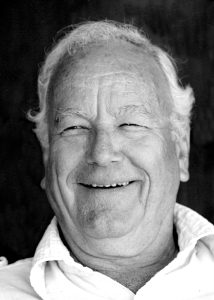
Photo: Art Evans
MacGregor and Devin made an agreement whereby MacGregor would build rollers in Northern Ireland and ship them to California where Bill would install Corvette running gears and Devin bodies. Bill designed a new and even more beautiful body for the car. The problem was that MacGregor demanded payment before shipment. After the first chassis, Bill didn’t have sufficient cash. So with hat in hand, I persuaded my father to finance the operation and we created a new company called Evans Industries. The plan was for Evans to pay MacGregor, Devin to complete each unit and Evans to do the marketing.
Bill completed the first car in 1958 and it became our demonstrator. Due to costs, we had to set the retail price at about the same cost as a 300SL, but significantly more than for an XK140. To put it mildly, and in spite of some great publicity, sales were not brisk. So Bill set out to design a less expensive sports car. He built a chassis and body designed around VW or Porsche 356 running gear, which I christened the Devin D (for Deutschland). When Chevrolet came out with the Corvair the next year, Bill modified the D frame to accept the Corvair engine and transmission and—voila!—we had the Devin C. Eventually, we sold some 200 Ds and Cs, about half of which were complete cars while the other half were delivered as kits.
During that time, we were truly a jolly band and had a lot of fun. Bob Bondurant joined us as parts manager, with my brother as his helper. Pete Woods was hired to be our sales manager. OCee and I had personally bought the prototype from Malcolm and I raced it during 1959. I made a deal with my buddy, Andy Porterfield, who was then working and racing a Corvette for a Los Angeles Chevrolet dealer. We put a hot Vette engine in one of our cars and Andy raced it at the first Times Grand Prix. Unfortunately, he failed to finish due to a mechanical problem, but our driver in the lady’s race, Ginny Sims, set a speed record down the back straight at Riverside.
To be blunt, Bill was never the easiest person with whom to deal. While undoubtedly a brilliant designer, he sometimes tended to be stubborn and opinionated. And I guess I wasn’t always easy to get along with either. In retrospect, it’s obvious that neither of us were very good at running the business part of the operation. We made a lot of mistakes and, while the products were outstanding, eventually everything came apart.
At my end, my father had a heart attack and had to retire. OCee and I lost our major client and our partnership went broke. Bill soldiered on for a few years and eventually tried to go into the roof-rack manufacturing business. Fortunately for Bill, Middie went into real estate and did very well at it.

When they lived in Yucaipa, Bill had a large garage next to the home where he had an office and shop. Until his death, he provided advice and parts for those who owned his cars, which by then had become valuable collector items much desired by vintage racers.
In 1985, I was able to buy an SS I found in the proverbial farmer’s barn. Also, I traded an extra car I had for a C. I had begun running a few vintage races, but always with Bill listed as the entrant. He enjoyed going to Laguna Seca in his large motorhome and camping near the circuit. A lot of camaraderie developed among Devin vintage drivers and their families with Bill always the center of attention.
My fondest remembrance of Bill was in November 1990 when we celebrated his 75th birthday with a grand gathering at my Palm Springs home. A large number of friends came to pay their respects. Phil Hill, Carroll Shelby, Zora Arkus-Duntov, John Von Neumann, Vasek Polak and Dan Gurney were a few of the guests I can recall. Bill was pleased so many had come to honor him and was as happy as I had seen him in a long time.
When I visited him in the hospital, he was 85 years old. He told me that this was the only time he had been a patient and it was also the first time he had ever seen a doctor! A few days later, he was gone.
Today, one of my treasures is my Devin D. It is the prototype (VIN DD-P) that Bill gave me on one of my birthdays. My aging memory doesn’t remember which one.





